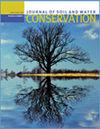The soil microbiome unveils strong imprints of artificial erosion after 27 years
IF 2.6
4区 农林科学
Q2 ECOLOGY
引用次数: 0
Abstract
Soil erosion is a severe and widespread form of land degradation worldwide, and is being exacerbated by effects of climate change, such as increased storm frequency and intensity. It is important to study the impact of soil erosion on the soil microbiome because soil microbes are crucial drivers of many important soil biological processes in agriculture. In 2016 and 2017, we sampled a simulated soil erosion field trial established in 1990 to investigate the effects of different depths of topsoil removal and restorative soil amendments on soil pH, microbial biomass carbon (MBC) and the activities of enzymes that mediate C, nitrogen (N), phosphorus (P), and sulfur (S) cycling, plus the diversity and composition of soil prokaryotic (bacteria and archaea) and fungal communities. The one-time (1990) treatments consisted of a split-plot combination of three depths of topsoil removal (0, 10, and 20 cm) as main plots, and three restorative soil amendments (check, topsoil, and cattle manure) as subplots. Soil pH was higher in the eroded treatments than the noneroded treatment, but the opposite was observed for MBC and the activities of β-glucosidase (C cycling) and N-acetyl-β-glucosinidase (C and N cycling). The restorative amendments did not affect soil pH, MBC, or enzyme activities. The relative abundances of the archaea Thaumarchaeota was higher in noneroded treatments than in eroded treatments, but the reverse was observed for the bacteria Chloroflexi, Gemmatimonadetes, Planctomycetes, and Verrucomicrobia. For fungi, the relative abundance of Basidiomycota was lower in eroded treatments than in the noneroded treatment, but the opposite was true for Mortierellomycota. The β-diversity analyses also showed different prokaryotic and fungal community structures between eroded and noneroded treatments, but the restorative amendment effects were less distinct. Therefore, soil erosion and excavation can have lasting imprints on the soil microbiome, particularly negative imprints on total microbial biomass and its C and N cycling potential, while imprints of restorative measures such as manure or topsoil amendment were not as strong. A single desurfacing event has effects that last for decades, and our efforts to reverse them are largely ineffective when applied only once.27年后,土壤微生物群揭示了人工侵蚀的强烈印记
土壤侵蚀是世界范围内土地退化的一种严重和广泛的形式,由于气候变化的影响,如风暴频率和强度的增加,土壤侵蚀正在加剧。研究土壤侵蚀对土壤微生物群的影响具有重要意义,因为土壤微生物是农业中许多重要土壤生物过程的关键驱动因素。2016年和2017年,我们对1990年建立的模拟土壤侵蚀大田试验进行了采样,研究了不同深度表土去除和恢复性土壤改良对土壤pH、微生物生物量碳(MBC)和调节C、氮、磷、硫循环的酶的活性,以及土壤原核生物(细菌和古细菌)和真菌群落的多样性和组成的影响。一次性(1990年)处理包括三种表层土壤去除深度(0、10和20 cm)作为主样地的分割样地组合,以及三种恢复性土壤改良剂(土壤、表层土壤和牛粪)作为次样地。侵蚀处理土壤pH值高于非侵蚀处理,而MBC、β-葡萄糖苷酶(C循环)和N-乙酰-β-葡萄糖苷酶(C和N循环)活性则相反。恢复性修正对土壤pH、MBC和酶活性没有影响。古细菌Thaumarchaeota的相对丰度在未侵蚀处理中高于侵蚀处理,而细菌Chloroflexi、gemmatimonadees、plantomycetes和Verrucomicrobia的相对丰度则相反。对真菌而言,侵蚀处理下担子菌的相对丰度低于未侵蚀处理,而Mortierellomycota的相对丰度则相反。β-多样性分析还显示,侵蚀处理与非侵蚀处理之间的原核生物和真菌群落结构存在差异,但修复修复效果不明显。因此,土壤侵蚀和挖掘对土壤微生物群的影响是持久的,特别是对微生物总量及其碳氮循环潜力的负面影响,而粪肥或表土改良等恢复措施的影响则不那么强烈。一次表面处理的影响会持续几十年,而我们想要扭转这种影响的努力,如果只应用一次,基本上是无效的。
本文章由计算机程序翻译,如有差异,请以英文原文为准。
求助全文
约1分钟内获得全文
求助全文
来源期刊
CiteScore
4.10
自引率
2.60%
发文量
0
审稿时长
3.3 months
期刊介绍:
The Journal of Soil and Water Conservation (JSWC) is a multidisciplinary journal of natural resource conservation research, practice, policy, and perspectives. The journal has two sections: the A Section containing various departments and features, and the Research Section containing peer-reviewed research papers.

 求助内容:
求助内容: 应助结果提醒方式:
应助结果提醒方式:


